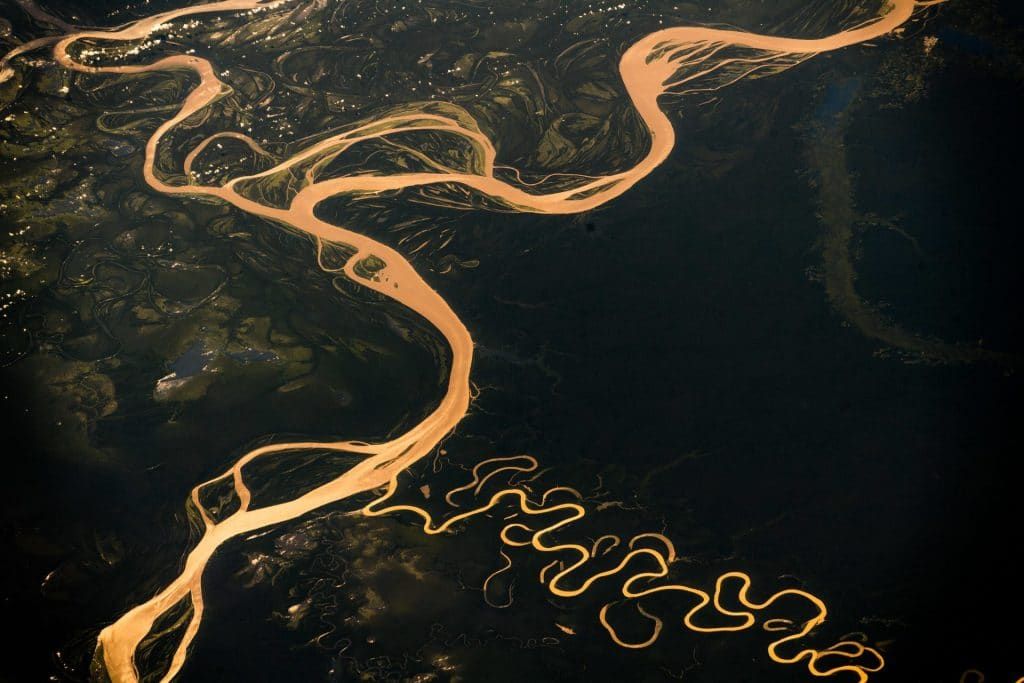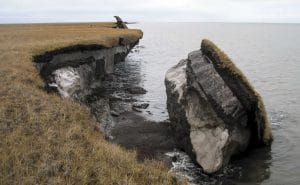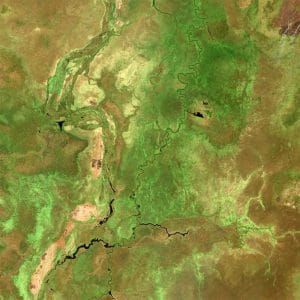Is Amazon rainforest going from carbon sink to carbon source?
By Fred Pearce | May 19, 2020
 The Amazon River as seen from the International Space Station on July 14, 2018. Image courtesy of European Space Agency astronaut Alexander Gerst, under Creative Commons license.
The Amazon River as seen from the International Space Station on July 14, 2018. Image courtesy of European Space Agency astronaut Alexander Gerst, under Creative Commons license.
Editor’s note: This story was originally published by Yale Environment 360. It appears here as part of the Climate Desk collaboration.
It is not often that you meet a scientist breathless with excitement about her new findings. But it happened to me last September at the National Institute for Space Research in the Brazilian research city of Sao Jose dos Campos. Atmospheric chemist Luciana Gatti was rushing to tell her colleagues the result of her latest analysis of carbon dioxide emissions from the Amazon rainforest, which she had completed that morning.
For a decade, her team had been sampling the air from sensors on aircraft flying over the world’s largest rainforest. Their collating of recent results showed that, perhaps for the first time in thousands of years, a large part of the Amazon had switched from absorbing carbon dioxide from the air, damping down global warming, to being a “source” of the greenhouse gas and thus speeding up warming.
“We have hit a tipping point,” Gatti almost shouted, caught between elation at her discovery and anguish at the consequences.
As she spoke, fires were burning across the Amazon, making headlines around the globe. But her findings were not the short-term result of the fires. They were based on measurements from before the upsurge in fires, and showed a long-term trend. She had previously observed the same thing briefly during drought years. But now it no longer mattered if it was a wet or a dry year, or how many fires there were, the sink had become a source. “Each year it gets worse,” she said. “We have to stop deforestation while we work out what to do.”
Gatti asked me to keep silent for the time being, while she prepared her data for publication. When I contacted her this month, her paper was still being finalized. But I can now tell the story. It vividly illustrates a growing dismay among climate scientists, who are seeing ecosystems around the world going the way of the Amazon.
The scientists are warning that past climate models used by the UN’s Intergovernmental Panel on Climate Change (IPCC) have not fully reflected the scale of the warming that lies ahead as carbon sinks die. These revelations are coming from three areas of research: Studies such as Gatti’s in the Amazon, showing forests turning from sinks to sources of carbon dioxide; a new generation of climate models that incorporate these findings into future projections of climate change, and whose early outputs are just emerging; and recent revelations that ecosystems are releasing rising volumes of methane—the second-most important greenhouse gas and of vital importance for temperatures in the next couple of decades.
The extra emissions, known as carbon-cycle feedbacks, could already be making the prospect of keeping warming below 2 degrees Celsius (3.6 degrees Fahrenheit)—the target agreed to in the Paris climate accord in 2015—all but impossible. The new modeling is likely to result in more pessimistic projections in the next scientific assessment from the IPCC, which is due—coronavirus-permitting—in April 2021.
Why the finding is important. Our planet’s land and oceans currently take up about half of all the carbon dioxide we put into the atmosphere. The gas dissolves in seawater and is absorbed by growing plants. Without these “carbon sinks,” warming to date would have been twice as great. We would already have exceeded the 2-degree Celsius target. But the question now is whether the take-up will remain as it is, or diminish.
That depends on how ecosystems respond to the extra gas in the air. This response takes two competing forms. First, the extra carbon dioxide speeds up plant growth. This fertilization effect means that forests absorb more dioxide as they grow, slowing the build-up in the air. Good news.
But the bad news is that the higher temperatures, also brought about by the added carbon dioxide, are pulling in the other direction, reducing nature’s ability to soak up carbon dioxide. This happens because warmer ocean waters dissolve less carbon dioxide, while soils release more of the gas and some forests suffer heat stress and die, or catch fire.
Both these feedbacks are in play. But the debilitating effects of the warming, especially when combined with deforestation, are becoming increasingly dominant, ecologists say. That is what Gatti has seen in the Amazon. And the trend is often happening faster than expected.
Gatti’s findings, while relating to the southeast of the Amazon, the region’s most heavily deforested area, suggest that the rainforest as a whole could be close to flipping from a sink to a source of carbon dioxide. The ability of intact areas of the rainforest to absorb carbon dioxide have already halved since the 1990s, says Carlos Nobre of the University of Sao Paulo, Brazil’s most noted climate scientist. Passing the tipping point for the whole forest would release more than 50 billion tons of carbon, he said recently, which is the equivalent of five years of global fossil-fuel and industrial emissions
Non-tropical forests remain largely in carbon “sink” mode. But other tropical rainforests appear to be following the Amazon in moving toward becoming carbon sources. Wannes Hubau, now at the Royal Museum of Central Africa in Belgium, reported recently that “overall, the uptake of carbon into Earth’s intact tropical forests peaked in the 1990s” and has been declining since. The jungles of tropical Africa began showing increased carbon losses around 2010, he found.
Another big concern is the impact of thawing permafrost. This frozen ground, which covers large areas of the far north, holds hundreds of billions of tons of carbon that could be released as the land thaws. How much and how fast is an unresolved question. But the signs are not good. One recent study in northern Canada found thawing had reached depths “already exceeding those projected to occur by 2090.”
The risks of such rapid runaway carbon releases to the atmosphere have been worrying ecologists for a while. That worry is now being reinforced by the projections of a new generation of climate models designed to factor in how ecosystems respond to climate change.
Until now, most climate models have largely confined themselves to assessing how our carbon dioxide emissions warm the air, and how that warming interacts with physical feedbacks such as reduced ice cover, elevated atmospheric water vapor, and changes to clouds. This remains a work in progress. I wrote here on Yale Environment 360 in February how new field research suggests that the ability of clouds to keep us cool could be drastically reduced as the world warms, pushing global heating into overdrive.

New climate models. When ecological feedbacks have been included in the models, it has mostly been in a very simplistic way. But new models being developed for the next IPCC assessment of climate science are changing that. For the first time, they capture the full range of possibilities for how nature’s ability to soak up carbon dioxide may change as the climate changes, says Richard Betts of Britain’s Met Office Hadley Center, one of the world’s top climate modeling groups. His initial assessment of the early outcomes of these new models is sounding alarm bells.
Writing with Zeke Hausfather, of the Breakthrough Institute, in a blog this month on the website Carbon Brief, he warns that many of the projections of the new models “end up with much higher carbon dioxide concentrations by 2100.” That means more warming. “The combination of high climate sensitivity and high carbon-cycle feedbacks could result in substantial warming, even under more moderate emissions scenarios,” they say.
Even a scenario that is “reasonably consistent with currently enacted climate policies” could deliver up to 5 degrees Celsius of warming rather than the current estimate of 3 degrees. This, Betts says, is “because the upper end of possible feedbacks results in 40 percent more carbon dioxide in the air than previously supposed: 936 parts per million [ppm] by 2100, compared to a prediction without the carbon-cycle feedbacks of 670 ppm.” (Current levels are 415 ppm, and pre-industrial levels were around 280 ppm.)
And if the world backtracks on existing climate policies, things could be a great deal worse. One such scenario based on this produced an almost unimaginable warming of 7.7 degrees Celsius (13.9 degrees Fahrenheit) by the end of the century, rather than the 6 degrees Celsius predicted without the carbon-cycle feedbacks.
Some researchers think such alarming findings should be dismissed out of hand. Katarzyna Tokarska of ETH Zurich, with others, claimed recently that models with extreme warming would not accurately “predict” current climate—and so were biased and unlikely to be realistic in their future predictions. According to these researchers, this means that, with “ambitious” action to reduce emissions, the world could meet the temperature target set by the Paris Agreement.
But others say that if climate change pushes ecosystems such as the Amazon beyond key tipping points, then the present is unlikely to be a reliable guide to the future.
Betts and Hausfather say that while the extreme outcomes of the new models are not the most likely, they represent “a risk that merits consideration.”
Peter Cox of the University of Exeter first introduced the carbon cycle into climate modeling in a 2000 paper that predicted that “carbon-cycle feedbacks could significantly accelerate climate change over the 21st century.” He says today that even he has been “surprised by the large increases in carbon dioxide in recent models when carbon-cycle feedbacks are switched on.” He warns that while the new models may not yet be accurate representations of the future, “they are very helpful to reveal the sensitivities of the real world.”
So it is a shame that not all these new carbon-savvy predictions will be included in the next IPCC assessment, as first intended. Hausfather says that the international effort to develop the new models is running “a year behind schedule,” and many of them will miss the deadline for being included as new research findings in the assessment, which is this October.
The growing concern about CO2 feedbacks comes on top of alarm about trends in atmospheric levels of the second most important greenhouse gas, methane. These are more than twice pre-industrial levels, and after a decade of stability until 2007 they have been rising again sharply. The National Oceanic and Space Administration estimated this month that methane levels in the atmosphere reached a record 1,875 parts per billion in 2019, after the second largest year-on-year leap ever recorded.
How come? Euan Nisbet of Royal Holloway, University of London, says isotopic analysis shows industrial emissions such as those from fracking remain important sources of methane. But the major reason for the recent upsurge is microbial emissions, mostly from the tropics.
Microbial emissions include agricultural sources such as rice paddies and the guts of cattle, but also microbes in natural ecosystems, particularly wetlands. When Nisbet flew from Uganda to Zambia collecting air samples last year, he found what he called “a great plume of methane” rising from wetland swamps around Lake Victoria and Lake Bangweulu. Mark Lunt of Edinburgh University has also found a dramatic increase in emissions from the Sudd, a vast wetland downstream of Lake Victoria on the Nile in South Sudan. The presumption is that warmer temperatures are making microbes more active.
Copernicus satellite view of the Sudd wetland in South Sudan. Image courtesy European Space Agency/Sentinel-2

None of this methane increase is built into even the new climate models with carbon-cycle feedbacks. These models mostly assume that methane levels in the air will remain stable. But the concern is growing that, even if technology can reduce industrial emissions, a warmer world will drive a continuing surge in methane levels—and more warming as a consequence.
That is a very big problem for efforts to meet the Paris target of halting warming below 2 degrees Celsius.
Methane typically lasts in the atmosphere for only a decade—much less than carbon dioxide. But while it is there, it packs a big warming punch. Measured over 20 years, each molecule of methane emitted has 84 times more warming effect than each molecule of carbon dioxide.
Climate models conventionally assess the warming impacts of greenhouse gases over a century. This effectively tunes them to emphasize the importance of carbon dioxide, and relegates methane to an also-ran. But if they were tuned to the shorter timeframe, methane would appear almost three times more important.
It seems odd that this shorter timeframe is rarely adopted, given that the world risks exceeding its two-degree warming limit by 2050. As Nisbet puts it, if natural ecosystems keep pumping out more methane as the world warms, “it may become very difficult to meet the Paris goals.”
Nature, it seems, is biting back. Having so far absorbed our pollution indiscretions, it now seems to be making them worse. We only have ourselves to blame.
Together, we make the world safer.
The Bulletin elevates expert voices above the noise. But as an independent nonprofit organization, our operations depend on the support of readers like you. Help us continue to deliver quality journalism that holds leaders accountable. Your support of our work at any level is important. In return, we promise our coverage will be understandable, influential, vigilant, solution-oriented, and fair-minded. Together we can make a difference.
Keywords: Amazon, carbon dioxide, carbon sink, climate change, climate crisis, climate models, global warming, rainforest
Topics: Climate Change














